US Healthcare Crisis: Private Insurance and Policy Solutions
VerifiedAdded on 2023/06/11
|7
|1875
|193
Essay
AI Summary
This essay examines the role of private health insurance in escalating healthcare costs in the United States, leading to a situation where many Americans, particularly those without insurance, are deprived of essential medical facilities. It highlights the direct fee system and the high percentage of Americans with private insurance, contrasting it with the significant portion of uninsured individuals, including children. The essay discusses government policies like Entitlement Reform, Prescription Drug Pricing initiatives, and programs like PEPFAR and the Health Care Workforce program aimed at addressing these issues. Furthermore, it proposes solutions such as granting doctors more autonomy in treatment decisions, capping healthcare expenses as a percentage of income, and focusing on managing chronic conditions through personalized in-home healthcare solutions. The analysis concludes that governmental intervention is crucial in reducing insurance costs and ensuring affordable healthcare access for all citizens, emphasizing a shift towards public programs and government-sponsored policies.
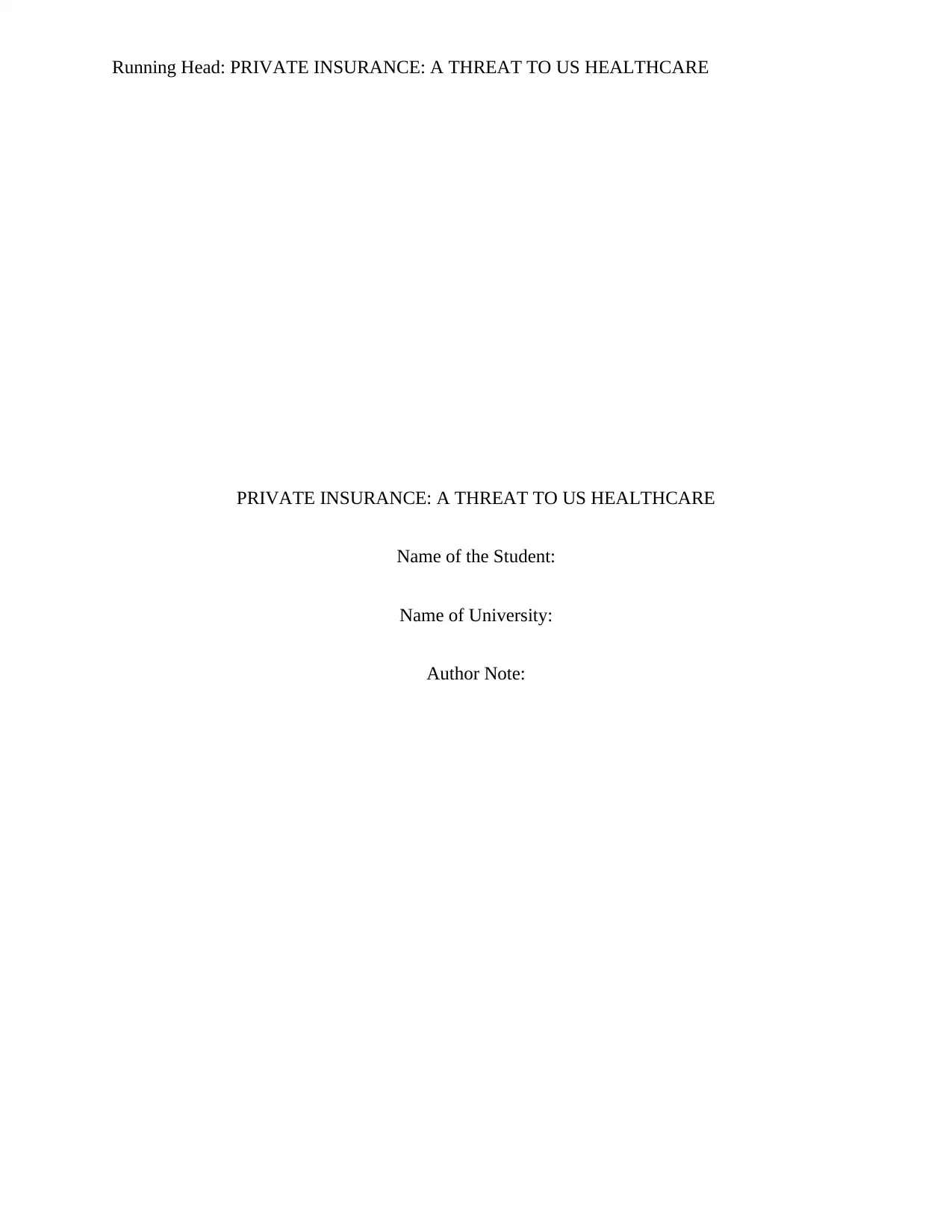
Running Head: PRIVATE INSURANCE: A THREAT TO US HEALTHCARE
PRIVATE INSURANCE: A THREAT TO US HEALTHCARE
Name of the Student:
Name of University:
Author Note:
PRIVATE INSURANCE: A THREAT TO US HEALTHCARE
Name of the Student:
Name of University:
Author Note:
Paraphrase This Document
Need a fresh take? Get an instant paraphrase of this document with our AI Paraphraser

1PRIVATE INSURANCE: A THREAT TO US HEALTHCARE
Health care is considered to be one of the important factors that require adequate
planning of the government and at the same time highlights the importance of the medical
facilities in order to create a flexible framework for the patients. In this regards, the health care
insurances play a significant role. Medicine is identified as a big business in United States
(Marks et al. 2017). In fact, since 1980 the costs in medicine have been escalated in an emphatic
manner with a rate of $2.6 trillion annually (Bhowmik et al. 2018). In this context, it becomes
important for the patients to cover a health insurance policy. Hence, the essay is going to
illustrate the role of private health insurance in increasing the costs of medical facilities. It is in
fact can be asserted that due to this escalation in the medical facility a number of people who do
not have that amount of money are deprived to get emergency medical facilities. Furthermore,
the discussion is followed by some preventive measures that are beneficial in order to make the
medical facilities accessible to every US citizen.
It can be argued that there are a number of reasons that foster obstacle to the health care
facilities in United States. In this regards, a direct free system is prevailed in the health care
sector of United States. According to this system it can be argued that patients under 65 are
expected to pay medical costs themselves aided by private health insurance (Marks et al. 2017).
It can be argued that 54 percent of the Americans have private insurances (Bhowmik et al. 2018).
About 29 percent have some form of public insurance and 16 percents are uninsured. Among this
16 percent almost 50 million Americans including 8 million children lack health insurance
(Myers 2017). As a result of that the health insurance has deadly consequences as it seems less
preventive health care service and the uninsured Americans. As a matter of fact, most of the
health care insurances are private in nature and have lots of terms and conditions. Expensiveness
is the main feature of those private insurances. Therefore, people with little income of money
Health care is considered to be one of the important factors that require adequate
planning of the government and at the same time highlights the importance of the medical
facilities in order to create a flexible framework for the patients. In this regards, the health care
insurances play a significant role. Medicine is identified as a big business in United States
(Marks et al. 2017). In fact, since 1980 the costs in medicine have been escalated in an emphatic
manner with a rate of $2.6 trillion annually (Bhowmik et al. 2018). In this context, it becomes
important for the patients to cover a health insurance policy. Hence, the essay is going to
illustrate the role of private health insurance in increasing the costs of medical facilities. It is in
fact can be asserted that due to this escalation in the medical facility a number of people who do
not have that amount of money are deprived to get emergency medical facilities. Furthermore,
the discussion is followed by some preventive measures that are beneficial in order to make the
medical facilities accessible to every US citizen.
It can be argued that there are a number of reasons that foster obstacle to the health care
facilities in United States. In this regards, a direct free system is prevailed in the health care
sector of United States. According to this system it can be argued that patients under 65 are
expected to pay medical costs themselves aided by private health insurance (Marks et al. 2017).
It can be argued that 54 percent of the Americans have private insurances (Bhowmik et al. 2018).
About 29 percent have some form of public insurance and 16 percents are uninsured. Among this
16 percent almost 50 million Americans including 8 million children lack health insurance
(Myers 2017). As a result of that the health insurance has deadly consequences as it seems less
preventive health care service and the uninsured Americans. As a matter of fact, most of the
health care insurances are private in nature and have lots of terms and conditions. Expensiveness
is the main feature of those private insurances. Therefore, people with little income of money
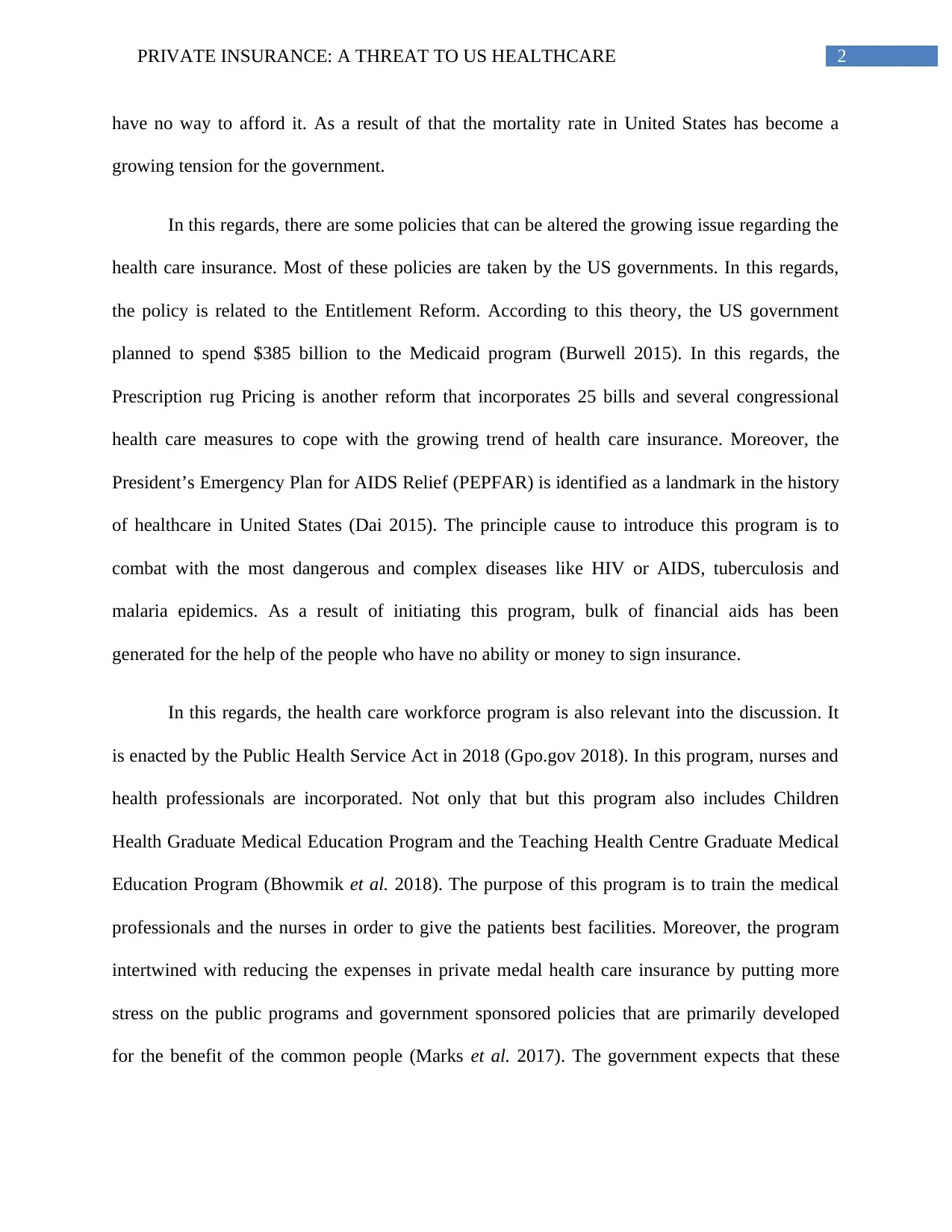
2PRIVATE INSURANCE: A THREAT TO US HEALTHCARE
have no way to afford it. As a result of that the mortality rate in United States has become a
growing tension for the government.
In this regards, there are some policies that can be altered the growing issue regarding the
health care insurance. Most of these policies are taken by the US governments. In this regards,
the policy is related to the Entitlement Reform. According to this theory, the US government
planned to spend $385 billion to the Medicaid program (Burwell 2015). In this regards, the
Prescription rug Pricing is another reform that incorporates 25 bills and several congressional
health care measures to cope with the growing trend of health care insurance. Moreover, the
President’s Emergency Plan for AIDS Relief (PEPFAR) is identified as a landmark in the history
of healthcare in United States (Dai 2015). The principle cause to introduce this program is to
combat with the most dangerous and complex diseases like HIV or AIDS, tuberculosis and
malaria epidemics. As a result of initiating this program, bulk of financial aids has been
generated for the help of the people who have no ability or money to sign insurance.
In this regards, the health care workforce program is also relevant into the discussion. It
is enacted by the Public Health Service Act in 2018 (Gpo.gov 2018). In this program, nurses and
health professionals are incorporated. Not only that but this program also includes Children
Health Graduate Medical Education Program and the Teaching Health Centre Graduate Medical
Education Program (Bhowmik et al. 2018). The purpose of this program is to train the medical
professionals and the nurses in order to give the patients best facilities. Moreover, the program
intertwined with reducing the expenses in private medal health care insurance by putting more
stress on the public programs and government sponsored policies that are primarily developed
for the benefit of the common people (Marks et al. 2017). The government expects that these
have no way to afford it. As a result of that the mortality rate in United States has become a
growing tension for the government.
In this regards, there are some policies that can be altered the growing issue regarding the
health care insurance. Most of these policies are taken by the US governments. In this regards,
the policy is related to the Entitlement Reform. According to this theory, the US government
planned to spend $385 billion to the Medicaid program (Burwell 2015). In this regards, the
Prescription rug Pricing is another reform that incorporates 25 bills and several congressional
health care measures to cope with the growing trend of health care insurance. Moreover, the
President’s Emergency Plan for AIDS Relief (PEPFAR) is identified as a landmark in the history
of healthcare in United States (Dai 2015). The principle cause to introduce this program is to
combat with the most dangerous and complex diseases like HIV or AIDS, tuberculosis and
malaria epidemics. As a result of initiating this program, bulk of financial aids has been
generated for the help of the people who have no ability or money to sign insurance.
In this regards, the health care workforce program is also relevant into the discussion. It
is enacted by the Public Health Service Act in 2018 (Gpo.gov 2018). In this program, nurses and
health professionals are incorporated. Not only that but this program also includes Children
Health Graduate Medical Education Program and the Teaching Health Centre Graduate Medical
Education Program (Bhowmik et al. 2018). The purpose of this program is to train the medical
professionals and the nurses in order to give the patients best facilities. Moreover, the program
intertwined with reducing the expenses in private medal health care insurance by putting more
stress on the public programs and government sponsored policies that are primarily developed
for the benefit of the common people (Marks et al. 2017). The government expects that these
⊘ This is a preview!⊘
Do you want full access?
Subscribe today to unlock all pages.

Trusted by 1+ million students worldwide

3PRIVATE INSURANCE: A THREAT TO US HEALTHCARE
policies will be beneficial for the people who are out of the private medical care insurance
facilities but have the need to cover their medical expenses.
The Doctor and the nurses of the private nursing homes should be given the liberty to
treat the patients on the basis of their own diagnosis and judgement. They should stop relying on
how the insurance companies instruct them to execute the treatment. In order to substantiate this
policy, the payment for performance regulation might be activated in the nursing care industry of
USA (Bhargava, Loewenstein and Sydnor, 2015).
As an impact of this policy, the health care provider and medical practitioners would
receive payment partly, based on the healthy outcomes of their treatment processes. The entire
payment will not be made on the basis of the number of the number of medical procedures they
have performed on a particular patient.
Another solution is that the provincial governments of USA might take resolutions that
the residents of the jurisdiction, irrespective of their age, income statement or insurance policy
would not spend more than 8% of their yearly income on health care (Cawley, Moriya and
Simon, 2015). In this case, exception is chronic illnesses and fatal cases. At present the average
Americans invest 25% of their yearly income on the health insurance. Gradual obligation of this
policy would help to achieve the target within the coming five years.
In order to facilitate the process, the cost savings from the new payment systems could be
reinvested. On the other hand, bureaucracy can also be reduced to enable patients to pay
affordably. This would help more people to provide premium quality of health care to their
family members.
policies will be beneficial for the people who are out of the private medical care insurance
facilities but have the need to cover their medical expenses.
The Doctor and the nurses of the private nursing homes should be given the liberty to
treat the patients on the basis of their own diagnosis and judgement. They should stop relying on
how the insurance companies instruct them to execute the treatment. In order to substantiate this
policy, the payment for performance regulation might be activated in the nursing care industry of
USA (Bhargava, Loewenstein and Sydnor, 2015).
As an impact of this policy, the health care provider and medical practitioners would
receive payment partly, based on the healthy outcomes of their treatment processes. The entire
payment will not be made on the basis of the number of the number of medical procedures they
have performed on a particular patient.
Another solution is that the provincial governments of USA might take resolutions that
the residents of the jurisdiction, irrespective of their age, income statement or insurance policy
would not spend more than 8% of their yearly income on health care (Cawley, Moriya and
Simon, 2015). In this case, exception is chronic illnesses and fatal cases. At present the average
Americans invest 25% of their yearly income on the health insurance. Gradual obligation of this
policy would help to achieve the target within the coming five years.
In order to facilitate the process, the cost savings from the new payment systems could be
reinvested. On the other hand, bureaucracy can also be reduced to enable patients to pay
affordably. This would help more people to provide premium quality of health care to their
family members.
Paraphrase This Document
Need a fresh take? Get an instant paraphrase of this document with our AI Paraphraser
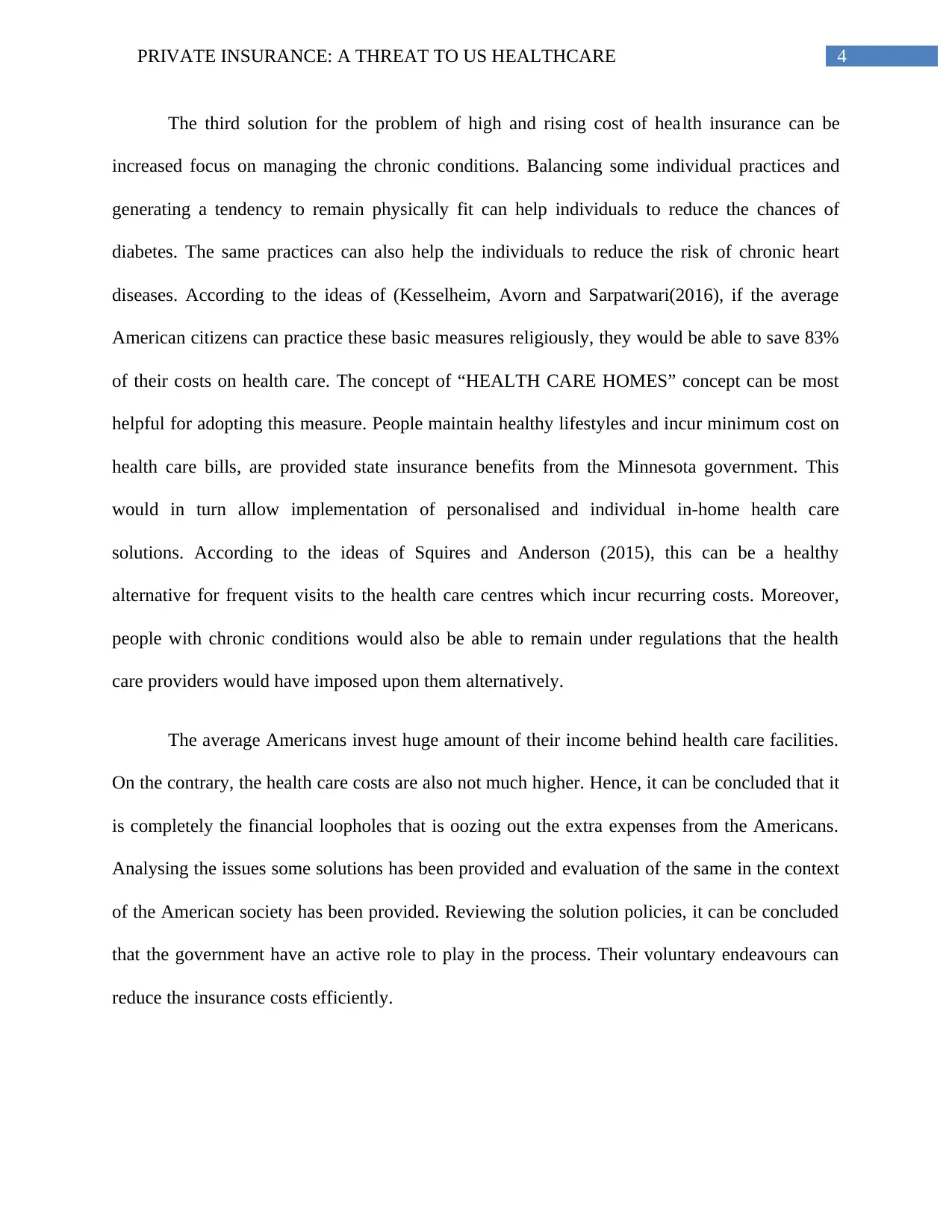
4PRIVATE INSURANCE: A THREAT TO US HEALTHCARE
The third solution for the problem of high and rising cost of health insurance can be
increased focus on managing the chronic conditions. Balancing some individual practices and
generating a tendency to remain physically fit can help individuals to reduce the chances of
diabetes. The same practices can also help the individuals to reduce the risk of chronic heart
diseases. According to the ideas of (Kesselheim, Avorn and Sarpatwari(2016), if the average
American citizens can practice these basic measures religiously, they would be able to save 83%
of their costs on health care. The concept of “HEALTH CARE HOMES” concept can be most
helpful for adopting this measure. People maintain healthy lifestyles and incur minimum cost on
health care bills, are provided state insurance benefits from the Minnesota government. This
would in turn allow implementation of personalised and individual in-home health care
solutions. According to the ideas of Squires and Anderson (2015), this can be a healthy
alternative for frequent visits to the health care centres which incur recurring costs. Moreover,
people with chronic conditions would also be able to remain under regulations that the health
care providers would have imposed upon them alternatively.
The average Americans invest huge amount of their income behind health care facilities.
On the contrary, the health care costs are also not much higher. Hence, it can be concluded that it
is completely the financial loopholes that is oozing out the extra expenses from the Americans.
Analysing the issues some solutions has been provided and evaluation of the same in the context
of the American society has been provided. Reviewing the solution policies, it can be concluded
that the government have an active role to play in the process. Their voluntary endeavours can
reduce the insurance costs efficiently.
The third solution for the problem of high and rising cost of health insurance can be
increased focus on managing the chronic conditions. Balancing some individual practices and
generating a tendency to remain physically fit can help individuals to reduce the chances of
diabetes. The same practices can also help the individuals to reduce the risk of chronic heart
diseases. According to the ideas of (Kesselheim, Avorn and Sarpatwari(2016), if the average
American citizens can practice these basic measures religiously, they would be able to save 83%
of their costs on health care. The concept of “HEALTH CARE HOMES” concept can be most
helpful for adopting this measure. People maintain healthy lifestyles and incur minimum cost on
health care bills, are provided state insurance benefits from the Minnesota government. This
would in turn allow implementation of personalised and individual in-home health care
solutions. According to the ideas of Squires and Anderson (2015), this can be a healthy
alternative for frequent visits to the health care centres which incur recurring costs. Moreover,
people with chronic conditions would also be able to remain under regulations that the health
care providers would have imposed upon them alternatively.
The average Americans invest huge amount of their income behind health care facilities.
On the contrary, the health care costs are also not much higher. Hence, it can be concluded that it
is completely the financial loopholes that is oozing out the extra expenses from the Americans.
Analysing the issues some solutions has been provided and evaluation of the same in the context
of the American society has been provided. Reviewing the solution policies, it can be concluded
that the government have an active role to play in the process. Their voluntary endeavours can
reduce the insurance costs efficiently.
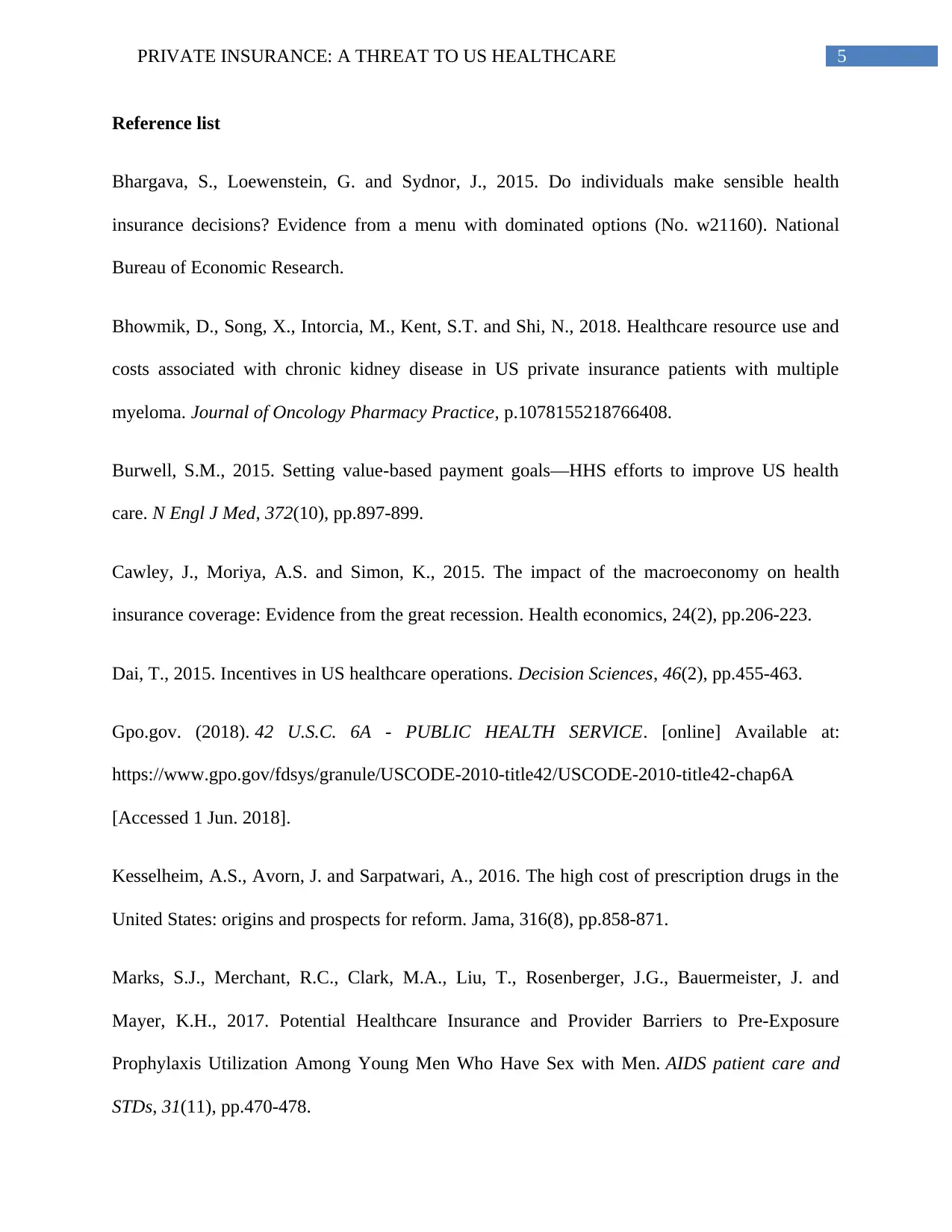
5PRIVATE INSURANCE: A THREAT TO US HEALTHCARE
Reference list
Bhargava, S., Loewenstein, G. and Sydnor, J., 2015. Do individuals make sensible health
insurance decisions? Evidence from a menu with dominated options (No. w21160). National
Bureau of Economic Research.
Bhowmik, D., Song, X., Intorcia, M., Kent, S.T. and Shi, N., 2018. Healthcare resource use and
costs associated with chronic kidney disease in US private insurance patients with multiple
myeloma. Journal of Oncology Pharmacy Practice, p.1078155218766408.
Burwell, S.M., 2015. Setting value-based payment goals—HHS efforts to improve US health
care. N Engl J Med, 372(10), pp.897-899.
Cawley, J., Moriya, A.S. and Simon, K., 2015. The impact of the macroeconomy on health
insurance coverage: Evidence from the great recession. Health economics, 24(2), pp.206-223.
Dai, T., 2015. Incentives in US healthcare operations. Decision Sciences, 46(2), pp.455-463.
Gpo.gov. (2018). 42 U.S.C. 6A - PUBLIC HEALTH SERVICE. [online] Available at:
https://www.gpo.gov/fdsys/granule/USCODE-2010-title42/USCODE-2010-title42-chap6A
[Accessed 1 Jun. 2018].
Kesselheim, A.S., Avorn, J. and Sarpatwari, A., 2016. The high cost of prescription drugs in the
United States: origins and prospects for reform. Jama, 316(8), pp.858-871.
Marks, S.J., Merchant, R.C., Clark, M.A., Liu, T., Rosenberger, J.G., Bauermeister, J. and
Mayer, K.H., 2017. Potential Healthcare Insurance and Provider Barriers to Pre-Exposure
Prophylaxis Utilization Among Young Men Who Have Sex with Men. AIDS patient care and
STDs, 31(11), pp.470-478.
Reference list
Bhargava, S., Loewenstein, G. and Sydnor, J., 2015. Do individuals make sensible health
insurance decisions? Evidence from a menu with dominated options (No. w21160). National
Bureau of Economic Research.
Bhowmik, D., Song, X., Intorcia, M., Kent, S.T. and Shi, N., 2018. Healthcare resource use and
costs associated with chronic kidney disease in US private insurance patients with multiple
myeloma. Journal of Oncology Pharmacy Practice, p.1078155218766408.
Burwell, S.M., 2015. Setting value-based payment goals—HHS efforts to improve US health
care. N Engl J Med, 372(10), pp.897-899.
Cawley, J., Moriya, A.S. and Simon, K., 2015. The impact of the macroeconomy on health
insurance coverage: Evidence from the great recession. Health economics, 24(2), pp.206-223.
Dai, T., 2015. Incentives in US healthcare operations. Decision Sciences, 46(2), pp.455-463.
Gpo.gov. (2018). 42 U.S.C. 6A - PUBLIC HEALTH SERVICE. [online] Available at:
https://www.gpo.gov/fdsys/granule/USCODE-2010-title42/USCODE-2010-title42-chap6A
[Accessed 1 Jun. 2018].
Kesselheim, A.S., Avorn, J. and Sarpatwari, A., 2016. The high cost of prescription drugs in the
United States: origins and prospects for reform. Jama, 316(8), pp.858-871.
Marks, S.J., Merchant, R.C., Clark, M.A., Liu, T., Rosenberger, J.G., Bauermeister, J. and
Mayer, K.H., 2017. Potential Healthcare Insurance and Provider Barriers to Pre-Exposure
Prophylaxis Utilization Among Young Men Who Have Sex with Men. AIDS patient care and
STDs, 31(11), pp.470-478.
⊘ This is a preview!⊘
Do you want full access?
Subscribe today to unlock all pages.

Trusted by 1+ million students worldwide
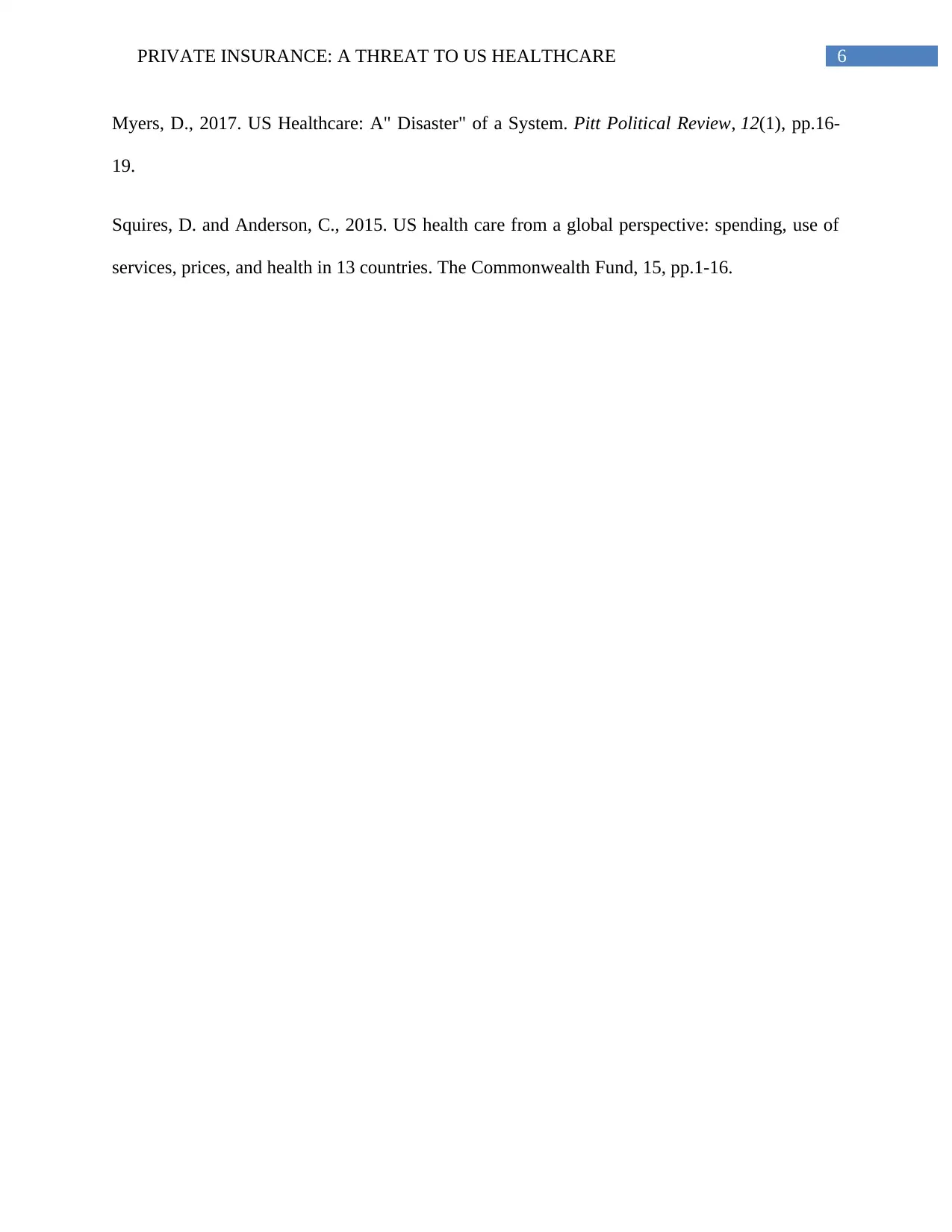
6PRIVATE INSURANCE: A THREAT TO US HEALTHCARE
Myers, D., 2017. US Healthcare: A" Disaster" of a System. Pitt Political Review, 12(1), pp.16-
19.
Squires, D. and Anderson, C., 2015. US health care from a global perspective: spending, use of
services, prices, and health in 13 countries. The Commonwealth Fund, 15, pp.1-16.
Myers, D., 2017. US Healthcare: A" Disaster" of a System. Pitt Political Review, 12(1), pp.16-
19.
Squires, D. and Anderson, C., 2015. US health care from a global perspective: spending, use of
services, prices, and health in 13 countries. The Commonwealth Fund, 15, pp.1-16.
1 out of 7
Related Documents
Your All-in-One AI-Powered Toolkit for Academic Success.
+13062052269
info@desklib.com
Available 24*7 on WhatsApp / Email
![[object Object]](/_next/static/media/star-bottom.7253800d.svg)
Unlock your academic potential
Copyright © 2020–2025 A2Z Services. All Rights Reserved. Developed and managed by ZUCOL.





